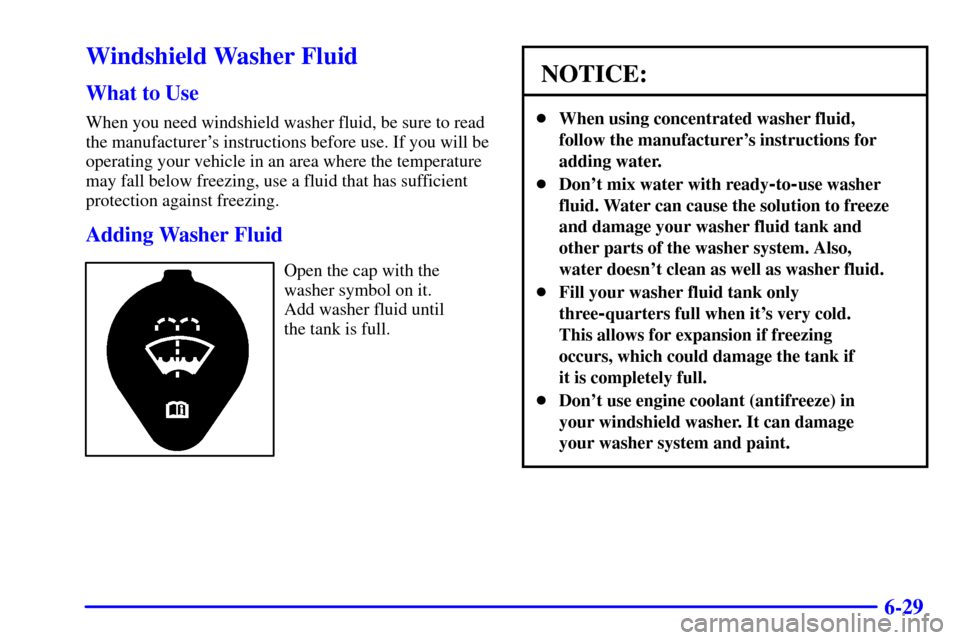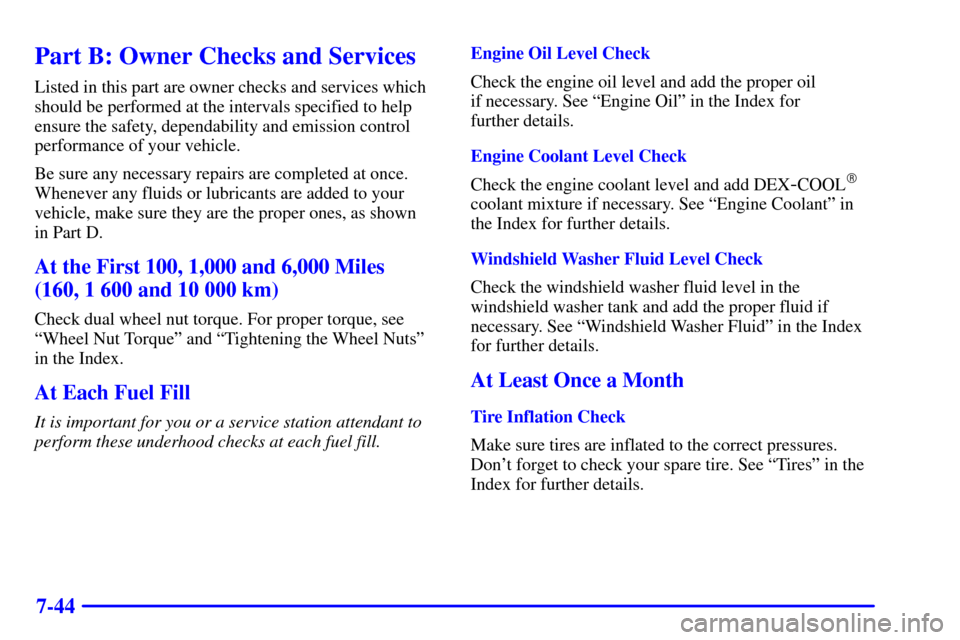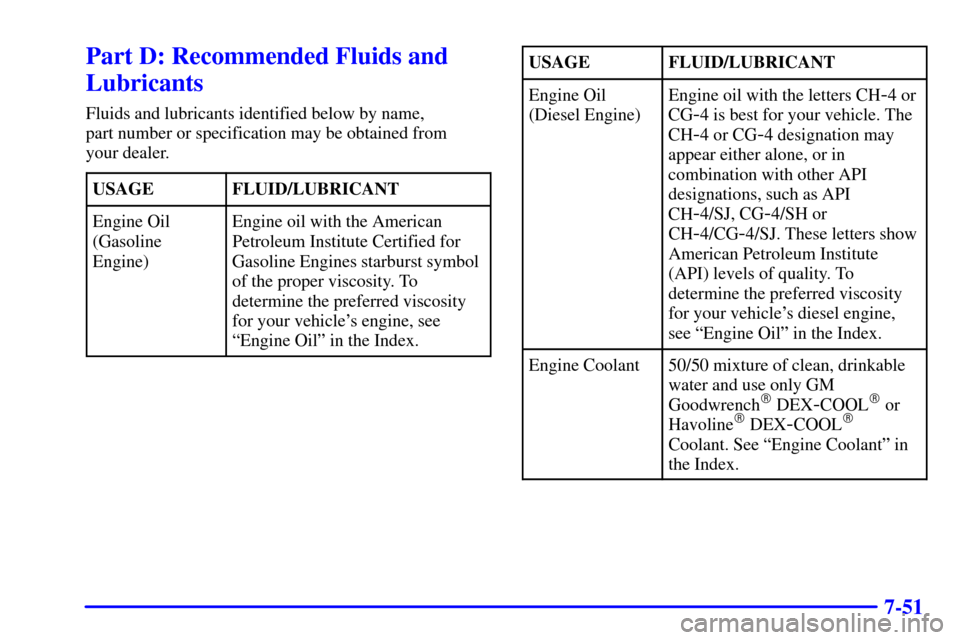Page 224 of 331

6-29
Windshield Washer Fluid
What to Use
When you need windshield washer fluid, be sure to read
the manufacturer's instructions before use. If you will be
operating your vehicle in an area where the temperature
may fall below freezing, use a fluid that has sufficient
protection against freezing.
Adding Washer Fluid
Open the cap with the
washer symbol on it.
Add washer fluid until
the tank is full.
NOTICE:
�When using concentrated washer fluid,
follow the manufacturer's instructions for
adding water.
�Don't mix water with ready
-to-use washer
fluid. Water can cause the solution to freeze
and damage your washer fluid tank and
other parts of the washer system. Also,
water doesn't clean as well as washer fluid.
�Fill your washer fluid tank only
three
-quarters full when it's very cold.
This allows for expansion if freezing
occurs, which could damage the tank if
it is completely full.
�Don't use engine coolant (antifreeze) in
your windshield washer. It can damage
your washer system and paint.
Page 257 of 331
6-62
Fuse/Circuit
BreakerUsage
1 Stop/TCC Switch, Buzzer,
Center High Mounted Stop Lamp,
Hazard Lamps, Stoplamps
2 Not Used
3 Courtesy Lamps, Cargo Lamp,
Glove Box Lamp, Dome/Reading
Lamps, Vanity Mirrors
4 Instrument Cluster, DRL Relay,
Lamp Switch, Keyless Entry,
Low Coolant Module,
Illuminated Entry Module,
DRAC (Diesel Engine)
5 Not Used
6 Cruise Control
7 Auxiliary Power Outlet
8 Crank
Page 292 of 331
Short Trip/City Scheduled Maintenance
7-29
100,000 Miles (166 000 km)
�Gasoline Engine Only: Inspect spark plug wires.
An Emission Control Service.
�Gasoline Engine Only: Replace spark plugs.
An Emission Control Service.
�Change automatic transmission fluid and filter. Manual transmission fluid
doesn't require change.
150,000 Miles (240 000 km)
�Drain, flush and refill cooling system (or every 60 months since last service,
whichever occurs first). See ªEngine Coolantº in the Index for what to use.
Inspect hoses. Clean radiator, condenser, pressure cap and neck. Pressure test
cooling system and pressure cap.
An Emission Control Service.
ACTUAL
SERVICED BY:MILEAGE
DATE
ACTUAL
SERVICED BY:MILEAGE
DATE
Page 306 of 331
Long Trip/Highway Scheduled Maintenance
7-43
100,000 Miles (166 000 km)
�Gasoline Engine Only: Inspect spark plug wires.
An Emission Control Service.
�Gasoline Engine Only: Replace spark plugs.
An Emission Control Service.
�Change automatic transmission fluid and filter. Manual transmission fluid
doesn't require change.
150,000 Miles (240 000 km)
�Drain, flush and refill cooling system (or every 60 months since last service,
whichever occurs first). See ªEngine Coolantº in the Index for what to use.
Inspect hoses. Clean radiator, condenser, pressure cap and neck. Pressure test
the cooling system and pressure cap.
An Emission Control Service.
ACTUAL
SERVICED BY:MILEAGE
DATE
ACTUAL
SERVICED BY:MILEAGE
DATE
Page 307 of 331

7-44
Part B: Owner Checks and Services
Listed in this part are owner checks and services which
should be performed at the intervals specified to help
ensure the safety, dependability and emission control
performance of your vehicle.
Be sure any necessary repairs are completed at once.
Whenever any fluids or lubricants are added to your
vehicle, make sure they are the proper ones, as shown
in Part D.
At the First 100, 1,000 and 6,000 Miles
(160, 1 600 and 10 000 km)
Check dual wheel nut torque. For proper torque, see
ªWheel Nut Torqueº and ªTightening the Wheel Nutsº
in the Index.
At Each Fuel Fill
It is important for you or a service station attendant to
perform these underhood checks at each fuel fill.Engine Oil Level Check
Check the engine oil level and add the proper oil
if necessary. See ªEngine Oilº in the Index for
further details.
Engine Coolant Level Check
Check the engine coolant level and add DEX
-COOL�
coolant mixture if necessary. See ªEngine Coolantº in
the Index for further details.
Windshield Washer Fluid Level Check
Check the windshield washer fluid level in the
windshield washer tank and add the proper fluid if
necessary. See ªWindshield Washer Fluidº in the Index
for further details.
At Least Once a Month
Tire Inflation Check
Make sure tires are inflated to the correct pressures.
Don't forget to check your spare tire. See ªTiresº in the
Index for further details.
Page 314 of 331

7-51
Part D: Recommended Fluids and
Lubricants
Fluids and lubricants identified below by name,
part number or specification may be obtained from
your dealer.
USAGE
FLUID/LUBRICANT
Engine Oil
(Gasoline
Engine)Engine oil with the American
Petroleum Institute Certified for
Gasoline Engines starburst symbol
of the proper viscosity. To
determine the preferred viscosity
for your vehicle's engine, see
ªEngine Oilº in the Index.
USAGEFLUID/LUBRICANT
Engine Oil
(Diesel Engine)Engine oil with the letters CH-4 or
CG
-4 is best for your vehicle. The
CH
-4 or CG-4 designation may
appear either alone, or in
combination with other API
designations, such as API
CH
-4/SJ, CG-4/SH or
CH
-4/CG-4/SJ. These letters show
American Petroleum Institute
(API) levels of quality. To
determine the preferred viscosity
for your vehicle's diesel engine,
see ªEngine Oilº in the Index.
Engine Coolant50/50 mixture of clean, drinkable
water and use only GM
Goodwrench
� DEX-COOL� or
Havoline� DEX-COOL�
Coolant. See ªEngine Coolantº in
the Index.